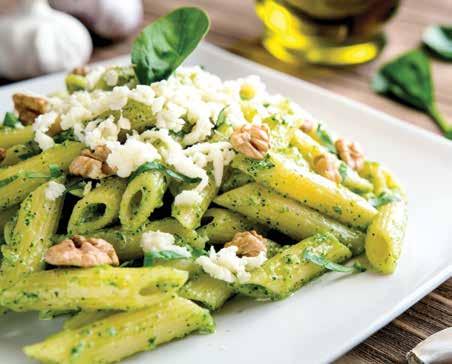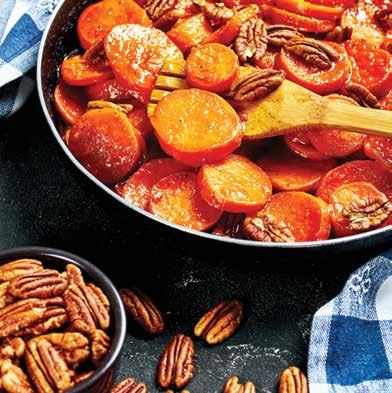
6 minute read
Nuts About Nuts
N u t s B y K i m B o i s v e r t
Advertisement
A B O U T N u t s
Nuts are a very versatile food. However, true nuts are actually fruits. Botanically speaking, a nut is a fruit composed of a hard shell and an edible seed, and the shell does not open to release the seed. Examples of true nuts are hazelnuts, chestnuts and acorns. Other nuts that do not fit the botanical definition are called culinary nuts, such as almonds, walnuts and pecans. The definition for culinary nuts is much less restrictive and generally covers all edible fruits or seeds found within a hard shell.
Even though nuts are small, they are nutritional powerhouses. They are a rich source of omega-3 fatty acids, which can lower cholesterol and protect against coronary artery disease. Nuts have strong anti-inflammatory properties. While inflammation is the body’s way of dealing with injury or fending off harmful pathogens, it can be damaging to organs if prolonged. Nuts are high in fiber, which contributes to a healthy gut. In addition, an increased fiber intake causes a sense of fullness and may reduce the number of calories consumed.
Nuts contain minerals such as magnesium, zinc, copper and selenium, as well as B-complex vitamins. These elements are powerful antioxidants that offer protection against heart disease, degenerative nerve disease, viral and fungal infections, and help to support a healthy immune system.
The best way to ensure nuts are fresh is to purchase them still in their shells. Buying in bulk is usually the most economical, but be sure to do so in a place with a high turnover so the nuts do not go stale in the bin. Constant exposure to oxygen will compromise their freshness. If convenience is more important than economy, most kinds of nuts can be purchased already shelled. Either use them quickly or store them properly, as the higher the oil content, the quicker they will turn rancid. For instance, wal

nuts and pine nuts will not last as long as almonds and cashews. Most nuts will keep for up to six months in a cool, dark cabinet. Storing them in the refrigerator will add another month or two to their shelf life, but freezing them is best for the long term. Nuts will stay fresh and crunchy for up to a year when frozen. Regardless of where they are stored, keep them in a sealed container, as nuts easily pick up odors around them. Date the container if you don’t plan to use them right away.
In spite of the nutritional benefits of eating nuts, they do cause problems for some individuals in the form of allergic reactions. The symptoms of an allergic reaction range from mild, such as hives or digestive discomfort, to anaphylaxis, a severe life-threatening reaction. Interestingly, the most common allergy offender is the peanut, which is not actually a nut, but a legume. Tree nuts such as almonds, walnuts, macadamia nuts and cashews are also common allergens. Because nuts have so many uses, it is not always obvious what to avoid. In addition to store-bought foods, nuts are common ingredients in Asian and Indian foods as well as in personal care products such as lotion, soap and hair care products.
Conversely, people with gluten or dairy allergies look to nuts to fill the nutritional gaps in their diets, as do followers of low carb lifestyles. Mainstream grocery stores now offer a plethora of nut-based flours. There are entire websites dedicated to substituting almond flour or coconut flour in cooking and baking. In addition, if dairy intolerance is an issue, the choices abound there as well. Options include almond milk, cashew milk and hazelnut milk, just to name a few.
There are so many ways to enjoy nuts and reap the nutritional benefits. Roast or sprout them for snacking. Mix walnuts, pistachios and almonds with dried fruit for a nourishing trail mix. Grind almonds with a pinch of salt in a food processor to make almond butter and replace peanut butter. Toast your favorite nut and top soups, salads, fish or ice cream. Bake a cake with almond flour and enjoy a slice with a hazelnut milk latte. The possibilities are endless.
PENNE PASTA WITH PESTO, WALNUTS AND MOZZARELLA CHEESE Serves 4
Ingredients: • 1-pound penne pasta • 8 ounces fresh mozzarella cheese • 1 1/4 cup pesto, recipe below • 1/4 cup fresh basil leaves, thinly sliced • 3/4 cup walnut pieces
Pesto • 2 cups fresh basil leaves • 1 cup fresh spinach • 1/3 cup extra virgin olive oil • 1/3 cup freshly grated Parmesan cheese • 1/2 cup pine nuts, toasted to golden brown • Juice from one lemon • 2 – 3 cloves of garlic, depending on taste • 1 teaspoon salt Directions:

Cook pasta according to the package directions to al dente. Drain well reserving one cup of the pasta water. In a food processor, combine all of the pesto ingredients and process until it reaches desired consistency. Add additional salt, lemon or garlic to taste. In a large bowl, toss the cooked pasta, pesto and basil. Use a little of the reserved pasta water if needed to loosen the pasta for even coating of the pesto. Top with shredded or cubed mozzarella cheese and walnuts.



BEET AND FETA TOAST Makes 32 appetizers
Directions: Ingredients: • 1 large ciabatta, cut into 32 thin slices • 1-pound roasted beets, thinly sliced • 12 ounces feta cheese, thinly sliced • Olive oil • 3/4 cup arugula • 3/4 cup walnut pieces • Freshly ground black pepper
Toast ciabatta slices then lightly spread each with olive oil. Layer each toast with sliced beet then sliced feta. Garnish with arugula and walnut pieces. Finish with freshly ground black pepper to taste.

Ingredients: • 2 pounds sweet potatoes, peeled and cut into 1/4-inch slices • 5 tablespoons butter • 1 cup brown sugar, packed • 1/2 teaspoon cinnamon • 1/2 cup orange juice • 3/4 cup pecans
Directions:
Melt the butter in a large heavy skillet over medium high heat. Add brown sugar, cinnamon and orange juice and bring to a simmer. Add the sweet potato slices to the pan and stir to coat them with the sugar mixture. Cover and simmer, turning the slices frequently, for 25 – 30 minutes until soft. In another skillet over medium heat toast the pecans. Turn frequently until they are light brown. Remove the pecans from the pan immediately to stop the cooking. Add the pecans to the sweet potatoes and continue to cook, stirring frequently to thorough ly glaze the sweet potatoes and pecans. Remove from heat when the syrup is thick to avoid scorching. Serve.
PLUM AND PISTACHIO TART Serves 8
Ingredients:
• 6 tablespoons butter • 1 cup superfine sugar • 4 eggs • 1/2 tablespoon vanilla • 1 teaspoon baking powder • 1 cup almond flour • 1 cup pistachios, finely ground • 3/4 cup flour • 12 ripe plums, halved and stoned • 2 cups powdered sugar • 3 – 4 tablespoons fresh lemon juice
Directions:
Preheat oven to 350 degrees. Lightly grease tart pan. Cream butter and sugar. Add eggs one at a time. Fold in almond flour, ground pistachios, flour, baking powder and vanilla. Mix well. Pour the batter into the prepared tart pan and smooth the surface. Top the batter with the plum halves, cut side up. Bake for 45 – 50 minutes or until a knife inserted in the center comes out clean. Cool in the pan. In a small bowl, mix powdered sugar and lemon juice to desired consistency. Glaze the tart and top with chopped pistachios.










